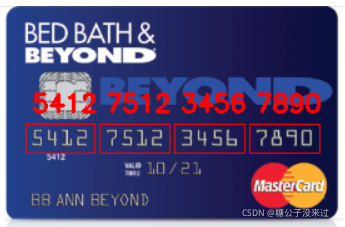项目要求
要求输入一张信用卡图片后能够识别出卡号的位置,并且识别出卡号是多少

输出图像如下图所示

实战
ocr_match_template.py
import cv2
import numpy as np
import myutils
# 指定信用卡类型
FIRST_NUMBER = {
"3": "American Express",
"4": "Visa",
"5": "MasterCard",
"6": "Discover Card"
}
# 建立cv_show函数,绘图展示
def cv_show(name, img):
cv2.imshow(name, img)
cv2.waitKey(0)
cv2.destroyAllWindows()
# 输入模板图像
template = cv2.imread("ocr_a_reference.png") # 里面如果像上面那样标注“0”的话,下面就不需要做灰度图了
# cv_show("template", template)
# 灰度图
ref = cv2.cvtColor(template, cv2.COLOR_BGR2GRAY)
# cv_show("ref", ref)
# 二值图像
ref = cv2.threshold(ref, 10, 255, cv2.THRESH_BINARY_INV)[1]
# cv_show("ref", ref)
# 计算轮廓
contours, hierarchy = cv2.findContours(ref, cv2.RETR_EXTERNAL, cv2.CHAIN_APPROX_SIMPLE)
# print(contours) # 找到了十个轮廓
cv2.drawContours(template, contours, -1, (0, 0, 255), 3)
cv_show("contours", template)myutils.py
import cv2
def sort_contours(cnts, method="left-to-right"):
reverse = False
i = 0
if method == "right-to-left" or method == "bottom-to-top":
reverse = True
if method == "top-to-bottom" or method == "bottom-to-top":
i = 1
boundingBoxes = [cv2.boundingRect(c) for c in cnts] # 用一个最小外接矩形将形状包起来
(cnt, boundingBoxes) = zip(*sorted(zip(cnts, boundingBoxes), key=lambda b: b[1][i], reverse=reverse))
# "key -- 主要是用来进行比较的元素,只有一个参数,具体的函数的参数就是取自于可迭代对象中,指定可迭代对象中的一个元素来进行排序。"
# key这里的匿名函数的作用还不是很了解,猜测可能是指定了每个矩形的左上角坐标的x坐标进行排序
# reverse -- 排序规则,reverse = True 降序 , reverse = False 升序(默认)
# https://www.cnblogs.com/huaziha/p/14373528.html
# 上面网址是找到的关于这个操作的解释的博客
return cnt, boundingBoxes
def resize(image, width=None, height=None, inter=cv2.INTER_AREA):
dim = None
(h, w) = image.shape[:2]
if width is None and height is None:
return image
if width is None:
r = height / float(h)
dim = (int(w * r), height)
else:
r = width / float(w)
dim = (width, int(h * r))
resized = cv2.resize(image, dim, interpolation=inter)
return resizedocr_match_template.py
refCnts = myutils.sort_contours(contours, method="left-to-right")[0]
digits = {}
for (i, c) in enumerate(refCnts):
# 计算外接矩形并resize成合适的大小
(x, y, w, h) = cv2.boundingRect(c)
roi = ref[y:y+h, x:x+w]
roi = cv2.resize(roi, (57, 88))
# 每一个数字对应每一个模板
digits[i] = roi
# 初始化卷积核
rectKernel = cv2.getStructuringElement(cv2.MORPH_RECT, (9, 3))
sqKernel = cv2.getStructuringElement(cv2.MORPH_RECT, (5, 5))
# 读取输入图像,预处理
image = cv2.imread("images/credit_card_03.png")
image = myutils.resize(image, width=300)
gray = cv2.cvtColor(image, cv2.COLOR_BGR2GRAY)
cv_show("gray", gray)
# 礼帽操作,突出更明亮的区域
tophat = cv2.morphologyEx(gray, cv2.MORPH_TOPHAT, rectKernel)
cv_show('tophat', tophat)
gradX = cv2.Sobel(tophat, ddepth=cv2.CV_32F, dx=1, dy=0, ksize=-1) # ksize=-1相当于用3*3的
gradX = np.absolute(gradX)
(minVal, maxVal) = (np.min(gradX), np.max(gradX))
gradX = (255 * ((gradX - minVal)/(maxVal - minVal)))
gradX = gradX.astype("uint8") # 有这一步之后处理出来的图像效果比没有这一步的好很多!
# print(np.array(gradX).shape)
# cv_show("gradX", gradX)
# 通过闭操作(先膨胀再腐蚀)将数字连在一起
gradX = cv2.morphologyEx(gradX, cv2.MORPH_CLOSE, rectKernel)
cv_show('gradX', gradX)
# THRESH_OTSU会自动寻找合适的阈值,适合双峰,需把阈值参数设置为0
thresh = cv2.threshold(gradX, 0, 255, cv2.THRESH_BINARY | cv2.THRESH_OTSU)[1]
# cv_show('thresh', thresh)
# 再来一个闭操作
thresh = cv2.morphologyEx(thresh, cv2.MORPH_CLOSE, sqKernel)
cv_show('thresh', thresh)
# 计算轮廓
threshCnts, hierarchy = cv2.findContours(thresh.copy(), cv2.RETR_EXTERNAL, cv2.CHAIN_APPROX_SIMPLE)
cnts = threshCnts
cur_img = image.copy()
cv2.drawContours(cur_img, cnts, -1, (0, 0, 255), 2)
cv_show('img', cur_img)
locs = []
# 遍历轮廓
for (i, c) in enumerate(cnts):
# 计算矩形
(x, y, w, h) = cv2.boundingRect(c)
ar = w / float(h)
if ar > 2.5 and ar < 4.0:
if (w > 40 and w < 55) and (h > 10 and h < 20):
locs.append((x, y, w, h))
# print(locs)
# 将符合的轮廓从左到右排列起来
locs = sorted(locs, key=lambda x: x[0])
# print(locs)
output = []
# 遍历每一个轮廓中的数字
for (i, (gX, gY, gW, gH)) in enumerate(locs):
groupOutput = []
group = gray[gY-5:gY+gH+5, gX-5:gX+gW+5]
# cv_show('group', group)
# 预处理
group = cv2.threshold(group, 0, 255, cv2.THRESH_BINARY | cv2.THRESH_OTSU)[1]
# cv_show('group2', group)
# 计算每一组的轮廓
digitCnts, herarchy = cv2.findContours(group, cv2.RETR_EXTERNAL, cv2.CHAIN_APPROX_SIMPLE)
digitCnts = myutils.sort_contours(digitCnts, method="left-to-right")[0]
# 计算每一组中的每个数值
for c in digitCnts:
# 找到当前数值的轮廓,并resize成合适的大小
(x, y, w, h) = cv2.boundingRect(c)
roi = group[y:y+h, x:x+w]
roi = cv2.resize(roi, (57, 88))
# cv_show('roi', roi)
# 计算匹配得分
scores = []
# 在模板中计算每一个的得分
for (digit, digitROI) in digits.items():
# 模板匹配
result = cv2.matchTemplate(roi, digitROI, cv2.TM_CCOEFF)
(_, score, _, _) = cv2.minMaxLoc(result)
scores.append(score)
# 得到最合适的数字
groupOutput.append(str(np.argmax(scores)))
# print(groupOutput)
# 画出来
cv2.rectangle(image, (gX-5, gY-5), (gX+gW+5, gY+gH+5), (0, 0, 255), 1)
cv2.putText(image, "".join(groupOutput), (gX, gY-15), cv2.FONT_HERSHEY_SIMPLEX, 0.65, (0, 0, 255), 2)
# 得到结果
output.extend(groupOutput)
# 打印结果
print(f"Credit Card Type: {FIRST_NUMBER[output[0]]}")
print(f"Credit Card #: {''.join(output)}")
cv2.imshow("image", image)
cv2.waitKey(0)成功!
























 1265
1265











 被折叠的 条评论
为什么被折叠?
被折叠的 条评论
为什么被折叠?








